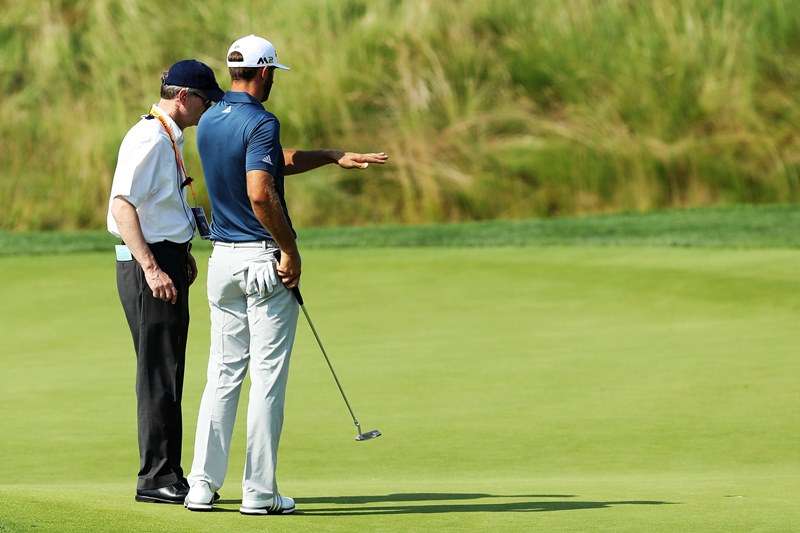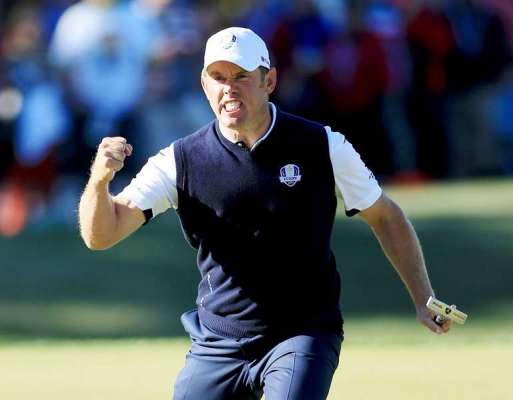Features
Farce may be reason we recall Johnson’s great win

Duck broken: Dustin Johnson lifts the US Open trophy, his first Major title (photo by Getty Images)
By John Huggan
The great shame of the 116th US Open at Oakmont is that it will not be remembered for the magnificent ball-striking that took Dustin Johnson to a long overdue maiden Major championship.
Instead – and not for the first time over the last few years – golf’s administrators shot themselves in the soft spikes when yet another display of arrogance mixed with pedantry severely damaged the game’s wider reputation and image. Sadly, to a world unfamiliar with the minutiae contained in the often unintelligible rules book, golf is a rather silly sport played by a group of terminally out-of-touch people who walk around with their misguided craniums stuck up their backsides. Or, as former PGA champion Tony Johnstone labelled their collective attitude on Twitter: HUBS (head up butt syndrome).
So, when we should be celebrating the brilliant play served up by the man who is surely the game’s most naturally gifted physical specimen, the talk is instead of whether or not Johnson caused a ball to move on a stupidly fast putting green that had been double cut and rolled to within an inch of its life. Without even addressing his putt that is. Ludicrous.
Let’s work backwards for a moment. Anyone looking at the leaderboard as Johnson putted out for what was a nifty closing birdie on the 72nd hole saw that the 31-year-old South Carolinian had just shot a closing 68 to be five-under par for the week and four shots clear of three runners-up: third-round leader Shane Lowry, 2003 US Open winner Jim Furyk and American Scott Piercy. It was a comfortable-enough victory in the end, one that surely saved the championship organiser, the United States Golf Association, from even more embarrassment.
That winning score was just fine as far as one USGA official was concerned, the one who originally deemed that the soon-to-be champion had not caused his ball to move on the 5th green. Trouble was, upon further review, some other members of the USGA decided that maybe Johnson was guilty of breaking Rule 18-2b and that a penalty of one shot should perhaps be applied.
Once that second decision had been made, Johnson had to be told. So, on the 12th tee – seven holes after the original incident – he was informed that he “might” be penalised after the round. So where there was certainty now there was confusion, the initial – and eventually correct – feeling being that Johnson would be adding one shot to his score after 18 holes.
This was wrong on so many levels, not least of which was the impact that this non-decision was inevitably going to have on the integrity of the competition. For example, what tactics and strategy could Johnson be expected to employ without knowing exactly where he stood? As four-time US Open champion Ben Hogan once said to a rules official: “If you’re going to penalise me, do it now so that I know where I stand.”
Plus, how was Johnson expected to approach a putt on the 72nd green to either tie or win – lag it down there or go for it? And last, but far from least, shouldn’t every competitor be immediately informed as to what was going on? Even a brief period of ignorance can hardly be classified as fair on either the field or Johnson.

Head shaker: Dustin Johnson talks to the official on the green at the 5th (photo by Getty Images)
Soon enough, strident reactions were popping up all across the golfing world. Speaking in his role as a commentator on America’s Fox Sports, former US Ryder Cup player Brad Faxon said: “What other sport would wait until the end of the game to make a ruling? This is ridiculous in my opinion.”
World No 3 Rory McIlroy – who had missed the cut – was another to weigh in on Twitter: “No penalty whatsoever for DJ. Let the guy play without this crap in his head. Amateur hour by the USGA.”
As ever, of course, the game’s ruling body in the US and Mexico was unrepentant. And, in the minds of everyone wearing a blue blazer, innocent of all charges.
“In making a determination about whether a player caused the ball to move, you look at a number of factors,” said official Thomas Pagel. “Certainly, there’s a recognition of Oakmont’s greens. We recognise that. But a couple of the other considerations you look at are the player’s actions and also the time that elapses between the player’s actions and the time that the ball moves. In Dustin’s case, he did ground his putter near the ball on two occasions, and it was shortly after he ground his putter the second time that the ball moved.”
In other words, there is nothing close to certainty here. No one, not least the USGA, has any idea whether Johnson’s practice stroke to the side of the ball did cause it to move. Given that doubt, shouldn’t the player be free to play on unmolested?
Almost unbelievably, Johnson was involved in another mildly controversial incident during his final round. After pulling his 3-wood tee-shot wildly to the left into thick rough off the 10th tee, the man from Myrtle Beach was allowed a “line of sight” free drop on to the adjacent 11th fairway because of an intervening television tower.
Fair enough. But after enjoying what was a huge slice of luck, Johnson then hit his approach to the green over said tower anyway. All straight and true by the strict letter of the law, but in such a situation a player surely has at least a moral obligation not to flaunt his good fortune by metaphorically sticking up two fingers to the integrity of the game. Sometimes, the rules of golf can make for very strange reading and even stranger application.
OK, enough. Amid all of the nonsense, a fascinating day’s golf was taking place, one containing all the usual elements of failure amid Johnson’s eventual triumph. The most prominent “victim”, of course, was Lowry. After starting the day with a four-shot lead, the genial Irishman with the killer wedge game was a sad figure by the end of a round that added up to 76.

Plenty to chew on: Shane Lowry in the final round (photo by Getty Images)
Perhaps worst of all, Lowry’s descent from the summit was of the inexorable variety, a slow, lingering death rather than one precipitated by huge disaster. By the turn his lead was gone, courtesy of a birdie-free outward half of 38. And when three successive bogeys further blotted his card from the 14th, the Irishman’s race was run.
That was bad enough, but an even worse nightmare in terms of scoring befell Lee Westwood. After finding sand off the first tee, the 43-year old Englishman made a sturdy par but quickly thereafter fell apart.
His second par figure did not arrive until the 8th, in-between there was carnage in the shape of five bogeys and a double bogey.
Out in 43, Westwood did well to shoot 80, his only “consolation” the fact that he has so far this year partnered the eventual winner in the last round of both Major championships.
Defending champion Jordan Spieth was another to suffer at the hands of Oakmont’s unforgiving combination of narrow fairways, thick rough, slick greens and punishing bunkers.
“The story of my week is just playing the easy holes poorly,” sighed the 22-year old Texan after signing off with a 75 for a nine-over par aggregate of 289.
“The funny thing is I felt like I didn’t have my game this week. If I play the easy holes at even par, I’m still in the top five. That’s what’s tough to swallow – it was the easy little iron/wedge holes that tore me apart.”
The final words, however, must belong to the new champion. Not, ahem, the deepest thinker in the game, Johnson nevertheless deserves his new-found status. He has suffered more than most. Who can forget his three-putt from 15 feet on the last green at Chambers Bay a year ago? Or the US PGA at Whistling Straits in 2010 when grounding his club in what turned out to be a bunker rather than a sandy waste area led to a two-shot penalty on the 72nd hole? There was also a closing 82 when leading the 2010 US Open and a 75-75 weekend in the Open last year after a promising start.
“Winning any tournament, there’s a lot of satisfaction,” he said, professing himself “not bothered” by the rules fracas on the 12th tee. “I didn’t think that I did anything to cause the ball to move, but at the end of the day, it didn’t affect what happened. But to get it done in a Major, especially as I’ve been so close so many times, is just an unbelievable feeling. It’s hard to even describe.”
A bit like the USGA then.
Tagged Dustin Johnson, Lee Westwood, US Open








